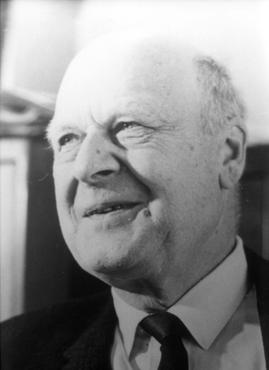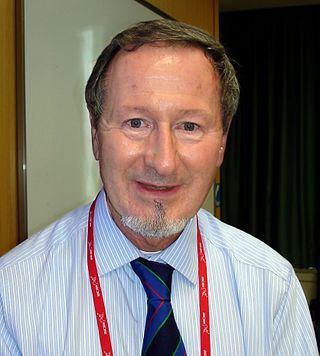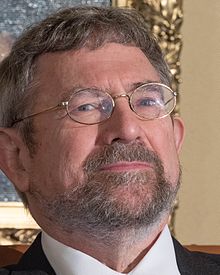
Lars Onsager was an American physical chemist and theoretical physicist. He held the Gibbs Professorship of Theoretical Chemistry at Yale University. He was awarded the Nobel Prize in Chemistry in 1968.

Yang Chen-Ning or Chen-Ning Yang, also known as C. N. Yang or by the English name Frank Yang, is a Chinese theoretical physicist who made significant contributions to statistical mechanics, integrable systems, gauge theory, and both particle physics and condensed matter physics. He and Tsung-Dao Lee received the 1957 Nobel Prize in Physics for their work on parity non-conservation of weak interaction. The two proposed that the conservation of parity, a physical law observed to hold in all other physical processes, is violated in the so-called weak nuclear reactions, those nuclear processes that result in the emission of beta or alpha particles. Yang is also well known for his collaboration with Robert Mills in developing non-abelian gauge theory, widely known as the Yang–Mills theory.

The Institut Laue–Langevin (ILL) is an internationally financed scientific facility, situated on the Polygone Scientifique in Grenoble, France. It is one of the world centres for research using neutrons. Founded in 1967 and honouring the physicists Max von Laue and Paul Langevin, the ILL provides one of the most intense neutron sources in the world and the most intense continuous neutron flux in the world in the moderator region: 1.5×1015 neutrons per second per cm2, with a thermal power of typically 58.3 MW.

Vitaly Lazarevich Ginzburg, ForMemRS was a Russian physicist who was honored with the Nobel Prize in Physics in 2003, together with Alexei Abrikosov and Anthony Leggett for their "pioneering contributions to the theory of superconductors and superfluids."

Douglas Dean Osheroff is an American physicist known for his work in experimental condensed matter physics, in particular for his co-discovery of superfluidity in Helium-3. For his contributions he shared the 1996 Nobel Prize in Physics along with David Lee and Robert C. Richardson. Osheroff is currently the J. G. Jackson and C. J. Wood Professor of Physics, emeritus, at Stanford University.

Leo Philip Kadanoff was an American physicist. He was a professor of physics at the University of Chicago and a former president of the American Physical Society (APS). He contributed to the fields of statistical physics, chaos theory, and theoretical condensed matter physics.
The Berezinskii–Kosterlitz–Thouless (BKT) transition is a phase transition of the two-dimensional (2-D) XY model in statistical physics. It is a transition from bound vortex-antivortex pairs at low temperatures to unpaired vortices and anti-vortices at some critical temperature. The transition is named for condensed matter physicists Vadim Berezinskii, John M. Kosterlitz and David J. Thouless. BKT transitions can be found in several 2-D systems in condensed matter physics that are approximated by the XY model, including Josephson junction arrays and thin disordered superconducting granular films. More recently, the term has been applied by the 2-D superconductor insulator transition community to the pinning of Cooper pairs in the insulating regime, due to similarities with the original vortex BKT transition.
Michael Ellis Fisher was an English physicist, as well as chemist and mathematician, known for his many seminal contributions to statistical physics, including but not restricted to the theory of phase transitions and critical phenomena. He was the Horace White Professor of Chemistry, Physics, and Mathematics at Cornell University. Later he moved to the University of Maryland College of Computer, Mathematical, and Natural Sciences, where he was University System of Maryland Regents Professor, a Distinguished University Professor and Distinguished Scholar-Teacher.
The superconductor–insulator transition is an example of a quantum phase transition, whereupon tuning some parameter in the Hamiltonian, a dramatic change in the behavior of the electrons occurs. The nature of how this transition occurs is disputed, and many studies seek to understand how the order parameter, , changes. Here is the amplitude of the order parameter, and is the phase. Most theories involve either the destruction of the amplitude of the order parameter - by a reduction in the density of states at the Fermi surface, or by destruction of the phase coherence; which results from the proliferation of vortices.

David James Thouless was a British condensed-matter physicist. He was the winner of the 1990 Wolf Prize and a laureate of the 2016 Nobel Prize for physics along with F. Duncan M. Haldane and J. Michael Kosterlitz for theoretical discoveries of topological phase transitions and topological phases of matter.

Giorgio Parisi is an Italian theoretical physicist, whose research has focused on quantum field theory, statistical mechanics and complex systems. His best known contributions are the QCD evolution equations for parton densities, obtained with Guido Altarelli, known as the Altarelli–Parisi or DGLAP equations, the exact solution of the Sherrington–Kirkpatrick model of spin glasses, the Kardar–Parisi–Zhang equation describing dynamic scaling of growing interfaces, and the study of whirling flocks of birds. He was awarded the 2021 Nobel Prize in Physics jointly with Klaus Hasselmann and Syukuro Manabe for groundbreaking contributions to theory of complex systems, in particular "for the discovery of the interplay of disorder and fluctuations in physical systems from atomic to planetary scales".
The hexatic phase is a state of matter that is between the solid and the isotropic liquid phases in two dimensional systems of particles. It is characterized by two order parameters: a short-range positional and a quasi-long-range orientational (sixfold) order. More generally, a hexatic is any phase that contains sixfold orientational order, in analogy with the nematic phase.
Thomas C. Spencer is an American mathematical physicist, known in particular for important contributions to constructive quantum field theory, statistical mechanics, and spectral theory of random operators. He is an emeritus faculty member at the Institute for Advanced Study.

Frederick Duncan Michael Haldane, known as F. Duncan Haldane, is a British-born physicist who is currently the Sherman Fairchild University Professor of Physics at Princeton University. He is a co-recipient of the 2016 Nobel Prize in Physics, along with David J. Thouless and J. Michael Kosterlitz.
Vadim L'vovich Berezinskii was a Soviet physicist. He was born in Kyiv, graduated from Moscow State University in 1959, and worked in Moscow and the Landau Institute for Theoretical Physics. He is famous for having identified the role played by topological defects in the low-temperature phase of two-dimensional systems with a continuous symmetry. His work led to the discovery of the Berezinskii–Kosterlitz–Thouless transition, for which John M. Kosterlitz and David J. Thouless were awarded the Nobel Prize in 2016. He also developed a technique for treating electrons in one-dimensional disordered systems and provided first consistent proof of one-dimensional localization, and predicted negative-gap superconductivity.

Jorge V. José is a Mexican/American physicist born in Mexico City. Currently the James H. Rudy Distinguished Professor of Physics at Indiana University. He has made seminal contributions to research in a variety of disciplines, including condensed matter physics, nonlinear dynamics, quantum chaos, biological physics, computational neuroscience and lately precision psychiatry. His pioneering work on the two-dimensional x-y model has been exceedingly influential in many areas of physics and has garnered many citations. He edited the book on the “40 Years of Berezinskii-Kosterlitz-Thouless Theory”, on two-dimensional topological phase transitions in 2013. Three years later KT were awarded the 2016 Nobel Physics Prize.
The KTHNY-theory describes the melting of crystals in two dimensions (2D). The name is derived from the initials of the surnames of John Michael Kosterlitz, David J. Thouless, Bertrand Halperin, David R. Nelson, and A. Peter Young, who developed the theory in the 1970s. It is, beside the Ising model in 2D and the XY model in 2D, one of the few theories, which can be solved analytically and which predicts a phase transition at a temperature .

The James Clerk Maxwell Medal and Prize is awarded by the Institute of Physics (IOP) in theoretical physics. The award is made "for exceptional early-career contributions to theoretical physics." It was awarded every two years between 1962 and 1970 and has since been awarded annually. It is named in honour of James Clerk Maxwell.











